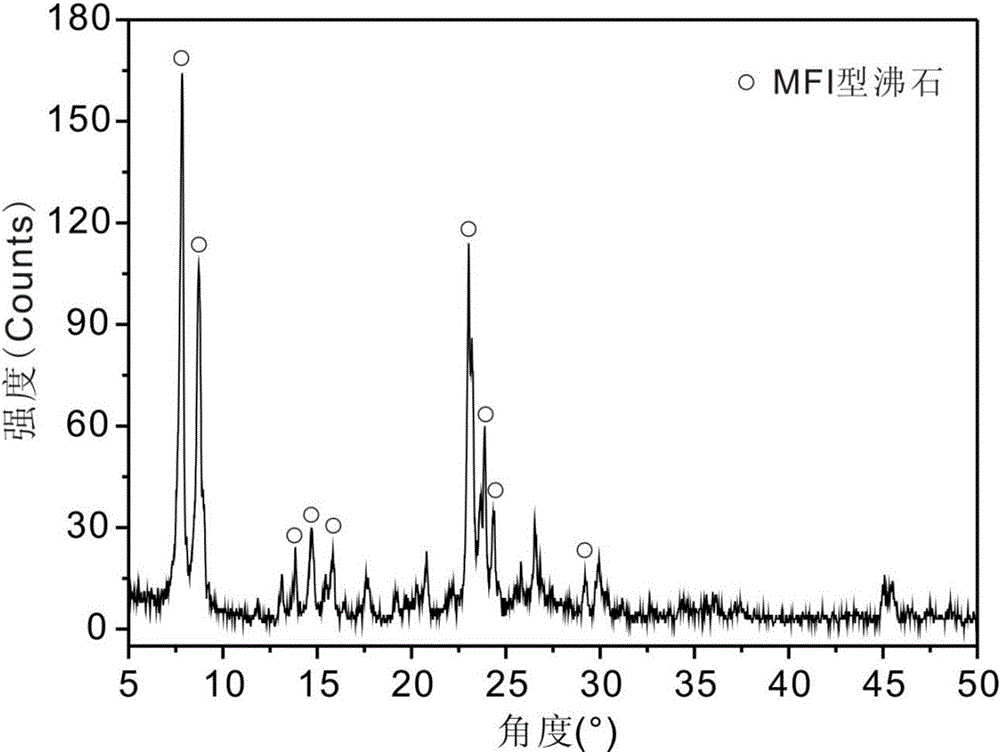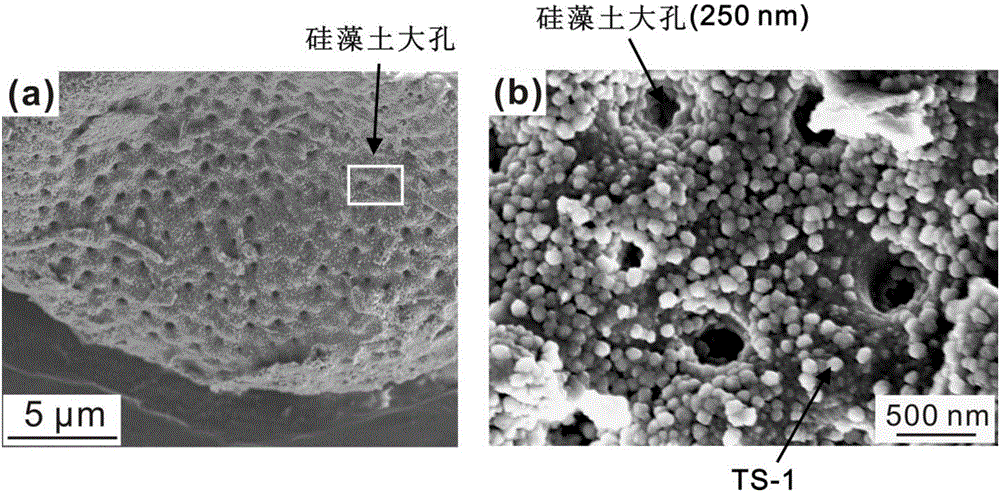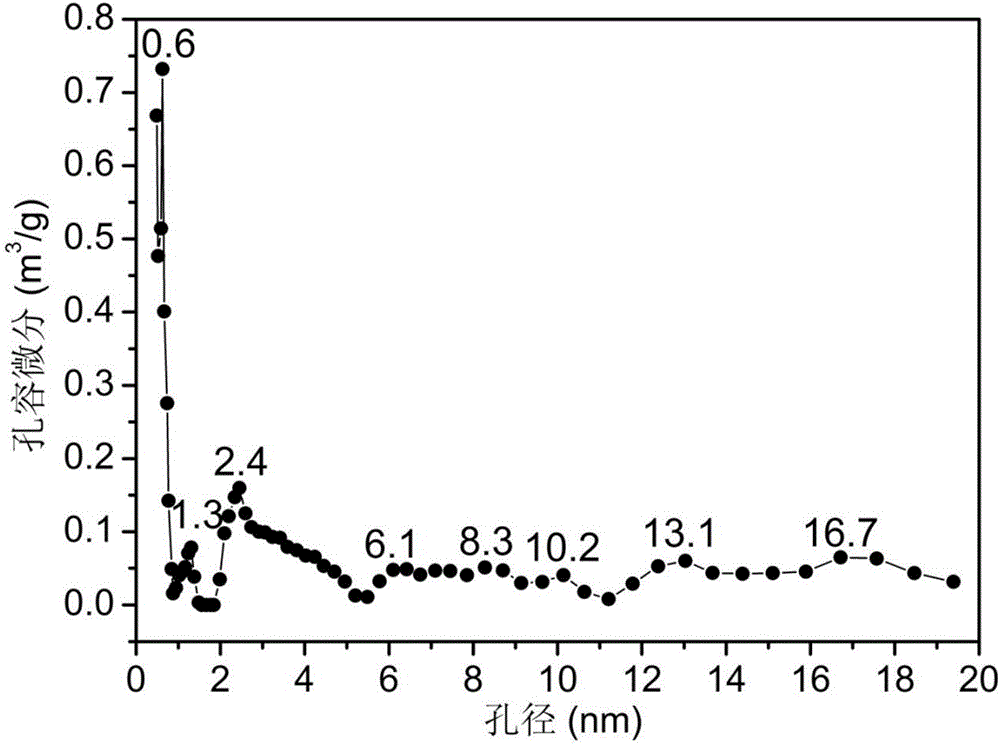Diatomite/nano TS-1 titanium silicalite composite material with hierarchical porous structure and preparation method of diatomite/nano TS-1 titanium silicalite composite material
A technology of titanium silicalite and pore structure, which is applied in the field of diatomite/nano TS-1 titanium silicalite composite material and its preparation, and can solve the problems of low utilization efficiency of active components, high cost and energy consumption, and cumbersome steps , to achieve the effects of low cost, improved utilization efficiency, and simple and easy process
- Summary
- Abstract
- Description
- Claims
- Application Information
AI Technical Summary
Problems solved by technology
Method used
Image
Examples
Embodiment 1
[0030] 1. Pretreatment of electrical inversion on the surface of diatomite: According to the mass ratio of diatomite / polycationic electrolyte solution volume ratio of 1g / 80mL, take 1.5g of diatomite powder and add 120mL of 0.5% polydimethyldimethy In the allyl ammonium chloride electrolyte solution (the preparation method is to dissolve polydimethyldiallyl ammonium chloride in water so that the mass fraction is 0.5%), the above mixed solution is fully stirred at room temperature for 2 hours, Then, the solid-liquid separation is carried out by centrifugation, the obtained solid is dried to constant weight, and the surface-modified diatomite powder is obtained.
[0031]2. Preparation of diatomite / nano TS-1 titanium silicalite composite material: 1.5 g of the surface-modified diatomite powder obtained in step 1 was added to 52.5 mL of TS-1 titanium silicalite synthesis solution (TS-1 The titanium silicalite synthesis solution is obtained by mixing ethyl orthosilicate, tetrabutyl ...
Embodiment 2
[0039] 1. Pretreatment of electrical inversion on the surface of diatomite: According to the mass ratio of diatomite / polycationic electrolyte solution volume ratio of 1g / 50mL, take 1.5g of diatomite powder and add 75mL of polyquaternary ammonium salt electrolyte with a mass fraction of 1.0% In the solution (its preparation method is to dissolve the polyquaternium salt in water so that the final mass fraction is 1.0%), the above-mentioned mixed solution is fully stirred at room temperature for 2 hours, and then the solid-liquid separation is carried out by centrifugation, and the obtained solid is dried. to constant weight to obtain surface-modified diatomite powder.
[0040] 2. Preparation of diatomite / nano TS-1 titanium silicalite composite material: 1.5 g of the surface-modified diatomite powder obtained in step 1 was added to 22.5 mL of TS-1 titanium silicalite synthesis solution (TS-1 The titanium silicalite synthesis solution is obtained by mixing ethyl orthosilicate, tet...
Embodiment 3
[0044] 1. Pretreatment of electrical inversion on the surface of diatomite: According to the mass ratio of diatomite / polycationic electrolyte solution volume ratio of 1g / 80mL, take 1.5g of diatomite powder and add 120mL of chitosan electrolyte solution with a mass fraction of 0.5% (the preparation method is to dissolve chitosan in water so that the final mass fraction is 0.5%), fully stir the above mixed solution at room temperature for 10 hours, and then carry out solid-liquid separation by centrifugation, and the obtained solid is dried to constant Then, the surface-modified diatomite powder was obtained.
[0045] 2. Preparation of diatomite / nano TS-1 titanium silicalite composite material: 1.5 g of the surface-modified diatomite powder obtained in step 1 was added to 52.5 mL of TS-1 titanium silicalite synthesis solution (TS-1 The titanium silicalite synthesis solution is obtained by mixing ethyl orthosilicate, tetrabutyl titanate, tetrapropylammonium hydroxide, isopropanol...
PUM
| Property | Measurement | Unit |
|---|---|---|
| Specific surface area | aaaaa | aaaaa |
| Total pore volume | aaaaa | aaaaa |
| Specific surface area | aaaaa | aaaaa |
Abstract
Description
Claims
Application Information
 Login to View More
Login to View More - R&D
- Intellectual Property
- Life Sciences
- Materials
- Tech Scout
- Unparalleled Data Quality
- Higher Quality Content
- 60% Fewer Hallucinations
Browse by: Latest US Patents, China's latest patents, Technical Efficacy Thesaurus, Application Domain, Technology Topic, Popular Technical Reports.
© 2025 PatSnap. All rights reserved.Legal|Privacy policy|Modern Slavery Act Transparency Statement|Sitemap|About US| Contact US: help@patsnap.com



